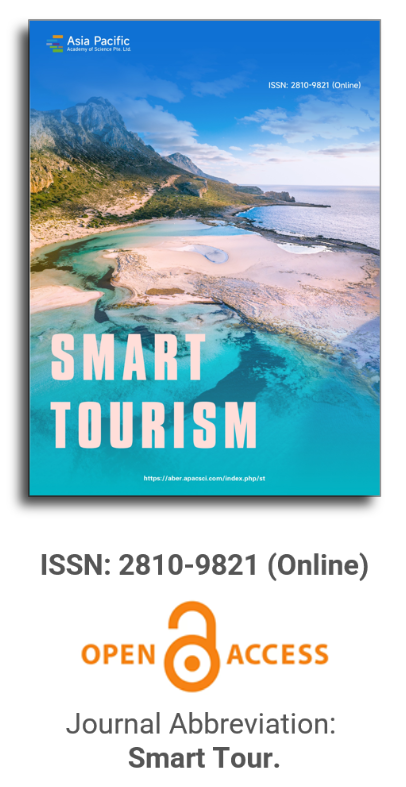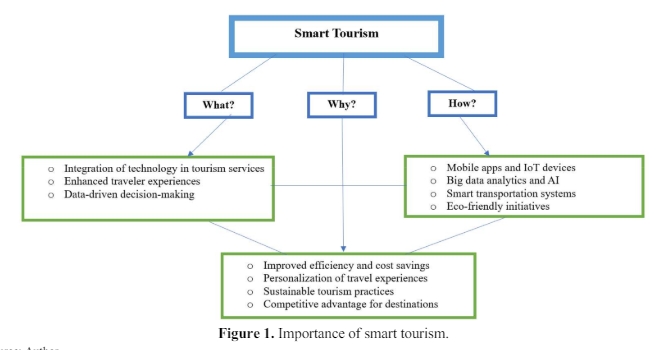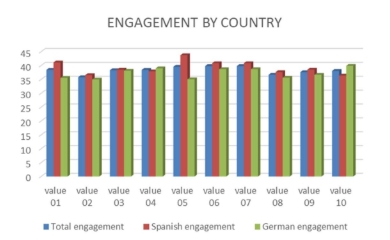


Issue release: 30 April 2022
Technological innovation has changed tourism management and practice, and tourism has become one of the largest industries in the world. As a result, tourism authorities must increasingly bet on the development of technology to accommodate tourists’ new image and make them feel included in their destination. In this respect, there is an important effective management of technological innovation in tourist destinations. Therefore, through theoretical methods and statistical committee previously conducted research on this issue, in these research methods are lacking, so this work aims to propose a technological innovation management method for tourist resorts. Thus, we have an approach to managing technological innovation in tourism destinations, expanding and integrating the indicators to be considered, and proposing the scale to measure the indicators. All of these provide the right tools for this purpose and facilitate the development of smart travel destinations.
Issue release: 30 April 2022
Taking the online group purchase of tourism products as the research perspective and the online group purchase virtual tourism flow of tourism products in 26 tourism destinations in China as the research data, this paper studies the spatial distribution differences and formation dynamic mechanism of virtual tourism flow through the method of spatial analysis. On the whole, the online group purchase virtual tourism flow shows weak discrete distribution characteristics, and some parts show certain aggregation. The virtual passenger flow is concentrated in the provinces with rich tourism resources in the south coast and central China, and the group purchase virtual tourism flow in the central and western regions, North China and Northeast China is small. The spatial distribution of group purchase virtual tourism flow is the result of the joint action of internal and external driving forces and environmental driving forces. The external driving forces include three main driving factors: product group purchase price, product type and network marketing spatial structure. Relevant analysis shows that group purchase price is the most important external driving factor, followed by product type and finally network marketing spatial structure. Taking group buying virtual tourism flow as the research perspective has a certain novelty, which makes up for the weakness of tourism flow in virtual space. The flow direction of virtual tourism flow can reflect the real tourism flow to a certain extent, and even guide the real tourism flow. The research of virtual tourism flow provides a predictive warning for the flow management and capacity management of scenic spots.
Issue release: 30 April 2022
Taking Jinjiang Wudian City Tourism Cultural and Creative Industrial Park as the research object, we use the case study method to explore the intelligent management system design scheme of the tourism cultural and creative industrial park, and through field interviews, data collection, data coding and result analysis, we deeply analyze the tourism cultural and creative industrial park in Jinjiang Wudian City. Through the methods of field interviews, data collection, coding and result analysis, we analyze the management subjects and components of the management mode of Wudian City Tourism and Creative Industry Park in Jinjiang and identify its existing management mode. On this basis, it embeds technical elements of wisdom tourism, subdivides wisdom management composition modules of tourism cultural and creative industrial park, and finally forms a complete wisdom tourism management system of tourism cultural and creative industrial park.
Issue release: 30 April 2022
Objective: This research article seeks to analyze how academic progress in the field of tourism places value on the need to adopt technological advances in the framework of development for a sustainable future, taking this into account, this research studied the discourse of the actors involved in the triple helix in the face of smart tourism and its implementation in Colombia. Method: The methodological strategy contemplated a hermeneutic and inductive perspective, from the Grounded Theory that interpreted the discourses of the University, the Company and the State facing the phenomenon of interest, the information was codified in the Software. Findings: As a result, gaps and key factors that would allow, from the perspective of the groups approached, the success of smart tourism strategies were obtained. Conclusion: The technological appropriation of the Colombian tourism sector reveals a gap especially in the capacity to generate an intelligent offer in relation to the experience perceived by the consumer. Likewise, the discourse shows that, within the need for integration of the triple helix, building an intelligent service for the value proposition is one of the most important challenges for the sector and therefore a lag that must be jointly intervened at government, academic and business levels.
Issue release: 30 April 2022
Through field survey, understanding the current situation of the smart tourist spot construction of Gulangyu in Xiamen, finding some problems such as the poor network coverage and communication, and incomplete data center. It puts forward feasible countermeasures from the four aspects such as the basis of the scenic area construction, supervision system construction, the intelligence services and marketing construction, environment and resources protection. It proposes the mode of composite construction of “the government leading, marketing orientation, the scenic spot construction”, expecting to promote the smart construction of Gulangyu.
Issue release: 30 April 2022
Objective: To systematize methodologies that harmonize the integrated and intelligent management of tourist destinations with geographic information, for timely and accurate decision making, contributing to quality in the context of the cantonal tourist territories of the province, Manabí-Ecuador.
Methodology/approach: The paradigms of tourism destination management that reconciles all participants, policies, components and parts of the system; expressed in an integrated management. The use of information and communication technologies in an intelligent management that welcomes tourists, communities and managers. Everything in tourism is tied to space and territory, the information systems that are used need to respond to the “where” by means of analysis tools and representation of the places.
Originality/Relevance: The sequence of steps of various methodologies and systematized theory, focus the integrated and intelligent management of tourist destinations, in the transit from the parts to the whole. In practice it implies, the voluntary participation of entrepreneurs, interested in the homogeneous improvement of tourism quality in the territory.
Main results: A theoretical model of the concepts that shape the understanding of the integrated and intelligent management of tourist destinations and territories for the improvement of quality. A methodology reconfigured from others, for the implementation of the theoretical model.
Theoretical / methodological contributions: Guidance for decision making in tourist territories and of understanding by entrepreneurs and managers, to revert the improvement of their businesses, in the homogeneous improvement of the tourist quality of the tourist territories and destinations of the province Manabí.
Issue release: 30 April 2022
As tourism sites, beaches offer opportunities for implementing technology solutions to streamline decision-making. The aim of this research is to examine the potential for intelligent beach management in Rosarito, Baja California, Mexico, as seen by visitors. This analysis will take into account the utilization of technology to facilitate social distancing measures, capacity control, and ICT for interpersonal communication. Based on a non-experimental, transactional field design, the methodology is quantitative. A probability sample of 595 visitors who were sent a questionnaire via the Internet between July and October 2020 was computed with a 95% confidence level and 4% error rate. The results of the multiple regression analysis show that the dependent variable, perception of confidence to visit the municipality's beaches, is related to the variables technologies to comply with the recommendations of social distancing from the COVID-19 pandemic, technologies to control access to the beach, and ICT to know the conditions of the tourist area. By implementing these technology components, the tourism industry will be able to continue operating while adhering to the relevant health and safety regulations.
Issue release: 30 April 2022
IPA analysis and descriptive statistical analysis are used to study the service quality of Yongtai qianjiangyue leisure farm. At present, the overall service quality of qianjiangyue belongs to the level of “general satisfaction”. To improve the service quality of qianjiangyue leisure farm, we should strengthen the infrastructure construction, strengthen the training of tourism practitioners, tap characteristic resources, increase cultural creativity and promote the construction of tourism intelligence.
Issue release: 30 April 2022
Tourism can become a strategy for local and regional development considering that tourism modes are increasingly expanding and adjusting to the needs of tourism consumers. The purpose of the research was oriented to diagnose the tourist potentialities of Báguanos municipality in Holguín province of Cuba, for the future implementation of a tourist development plan. The municipality and its potentialities for tourism development were characterized, the first two stages of the methodology used (Preparation and Diagnosis) were developed, it is concluded that Báguanos has a great amount of resources that are not being exploited and presents deficiencies in the management of the tourist infrastructure.
Issue release: 30 April 2022
Building a smart tourism ecosystem is an important means for the tourism industry to strengthen resource sharing, realize value co-creation and promote healthy development of the industry. Based on the ecological governance perspective and the theory of smart tourism, the connotation of smart tourism ecosystem is proposed and the structural framework of smart tourism ecosystem is constructed by using semi-structured interview method. The framework of smart tourism ecosystem consists of smart tourism platform, smart government, smart tourism suppliers, smart tourism destination marketing organization, smart tourism consumers and external environment, defines the role of each element in the structural framework, and analyzes the characteristics of data flow between each element. The polycentric governance mechanism of the smart tourism ecosystem, including the ecological governance mechanism of smart government, smart tourism suppliers, smart tourism destination marketing organizations and smart tourism consumers, is proposed to provide a reference for the construction and development of regional smart tourism ecosystem.
Issue release: 30 April 2022
Destinations are considered brands that must be properly managed to increase not only tourist arrivals but also the quality of life of residents. Brand equity plays an important role in achieving such objectives. Simultaneously, the integration of ICT in the territory has led to the concept of “smart destinations”. In this context, the aim of the paper is to develop a value model of smart destinations from the perspective of residents (key actor of destinations as they project their image and influence the tourist experience). Our model includes smart services related to safety, health, heritage, mobility and environment. Our results confirm that smart destination value is formed by recognition, image, perceived quality and loyalty. In addition, safety, environment and mobility services are the main antecedents of smart destination value.
Issue release: 30 April 2022
This article aims to contribute to the construction of critical thinking on tourism, providing reflections on the concept of Smart Tourism Destinations, which should, in the author’s opinion, be considered for its timely reconstruction. The concept of intelligence that sustains it is basically questioned, as well as some dangers related to its competitive and commercializing simplification. The methodology is based on argumentative bibliographic research, and is complemented with results of previous empirical research, which are inspired by critical epistemology, which questions the traditional tendency in the construction of knowledge about tourism. It concludes by substantiating a much more encompassing conception of human intelligence and reafirming the need for a methodology aimed at developing all the intellectual, emotional and spiritual potentialities of the people who inhabit the destinations.
Issue release: 30 April 2022
Despite coming from Western nations, the term “smart tourism” has “taken root and flourished” in China. In addition to reflecting the reality of how smart tourism is developing in China, current knowledge in the country's academic and industrial sectors also stimulates more study into the concept and tactics of smart tourism. This study offers fresh perspectives on the meaning and notion of smart tourism from the standpoint of rational choice theory, based on an understanding and analysis of the original mainstream technology application theory. It comes to the conclusion that encouraging travelers to make the best logical decision is the fundamental feature of smart tourism.

Prof. Hung-Che Wu
Nanfang College, Guangzhou
China
Indexing & Archiving
Asia Pacific Academy of Science Pte. Ltd. (APACSCI) specializes in international journal publishing. APACSCI adopts the open access publishing model and provides an important communication bridge for academic groups whose interest fields include engineering, technology, medicine, computer, mathematics, agriculture and forestry, and environment.


 Open Access
Open Access

.jpg)
.jpg)

.jpg)

